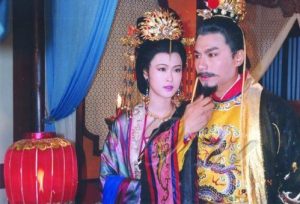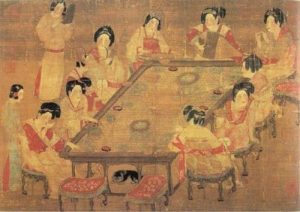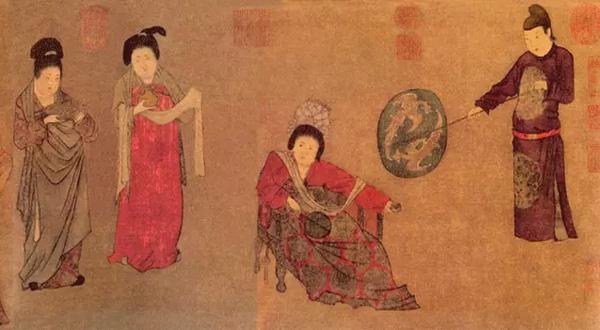(618-907)
In his final years as ruler, Emperor Yang of the Sui Dynasty (581-618) became increasingly despotic and detached from the suffering of his people. He commissioned great construction projects that crippled the country’s finances, masterminded disastrous war campaigns that resulted in the death of thousands, and oppressed his citizens to the point of rebellion. When widespread revolts broke out throughout the country, he was forced to retreat to the southern capital of Jiangdu (present-day Yangzhou) in 616.
Meanwhile, the rebel warlord Li Mi ruled the area surrounding Luoyang, Dou Jiande controlled the northeast, and Xue Ju dominated the northwest. Only Li Yuan, who reigned over Shanxi province, stood by the Sui Dynasty’s side. Just two years later, in light of the grief and devastation that he had caused, Emperor Yang was murdered by his advisors at the imperial palace. The throne was ripe for usurpation. Seizing his opportunity, Li Yuan briefly enthroned a Sui prince as Emperor Gong before forcing him to abdicate and claiming the throne for himself. He thereby proclaimed himself Emperor Gaozu of the Tang Dynasty.

But it wasn’t time to celebrate just yet! Emperor Gaozu was one of many contenders trying to grasp control of the Sui Empire. From the outset, he had five principle opponents to defeat: the rebel warlords Xue Ju, Li Mi, and Dou Jiande; Wang Shichong and the Sui remnants at Luoyang; and Yuwen Huaji, who led the remaining Sui southern armies. It wasn’t until 624, after six long years of fighting, that Emperor Gaozu was finally able to vanquish his rivals and unite China under his rule. Yet these efforts certainly weren’t in vain, as he had just ushered in a golden age in Chinese history.
As well as adopting the innovations of the preceding Sui Dynasty, such as the Confucian Examination System and the Three Departments and Six Ministries System, the Tang Dynasty also developed many famous advancements of their own. Under their firm leadership, the population boomed, trade on the Silk Road blossomed, foreign religions such as Buddhism and Nestorian Christianity thrived, and cultural exchange was at an all-time high.
 The advent of wood-block printing meant that literary works could be produced and disseminated with greater ease, while eminent poets such as Li Bai and Du Fu came to the fore. During this time, the legendary Buddhist monk Xuanzang made his fabled journey to the west, where he travelled to India and returned with invaluable scrolls of Buddhist texts. Among these manuscripts, a copy that was made of the Diamond Sutra would later come to be recognised as the oldest surviving complete printed book. In short, many would look back on the Tang Dynasty as the pinnacle of ancient Chinese culture and civilization.
The advent of wood-block printing meant that literary works could be produced and disseminated with greater ease, while eminent poets such as Li Bai and Du Fu came to the fore. During this time, the legendary Buddhist monk Xuanzang made his fabled journey to the west, where he travelled to India and returned with invaluable scrolls of Buddhist texts. Among these manuscripts, a copy that was made of the Diamond Sutra would later come to be recognised as the oldest surviving complete printed book. In short, many would look back on the Tang Dynasty as the pinnacle of ancient Chinese culture and civilization.
However, it would be unwise to think that one family could effectively rule a country as large as China for nearly 300 years. The Li clan may have traced their origins back to the great Taoist philosopher Laozi, but not all of them were quite as sagacious! While some Tang emperors like Taizong and Xuanzong would be celebrated for their great leadership, others like Gaozong and Zhongzong would fall victim to court intrigues, wily eunuchs, and the domineering influence of cunning concubines. In fact, the Tang was the only time in Chinese history when a woman, rather than manipulating the emperor from behind the scenes, would instead take the throne for herself!
From the reign of Empress Wu Zetian through to the tragic An Lushan Rebellion, the Tang Dynasty was riddled with more court drama than a soap opera! At its apex during the 8th century, it boasted a population of over 50 million citizens, expanded its influence across Korea, Vietnam, and Japan, and represented a cultural mecca along the ancient Silk Road. Yet this glory came at a great cost and the less well-equipped Tang emperors simply were not able to carry such a heavy burden on their shoulders. When the Tang Dynasty finally collapsed, it heralded in another chaotic and fractured era known as the Five Dynasties and Ten Kingdoms Period (907-960). It seemed that, like so many others, this golden age in Chinese history was doomed to begin and end in bloody warfare.
